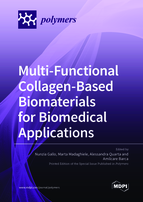Multi-Functional Collagen-Based Biomaterials for Biomedical Applications
A special issue of Polymers (ISSN 2073-4360). This special issue belongs to the section "Biomacromolecules, Biobased and Biodegradable Polymers".
Deadline for manuscript submissions: closed (25 February 2023) | Viewed by 37726
Special Issue Editors
Interests: regenerative medicine; medical devices; biomaterials; collagen; scaffolds; drug delivery systems
Special Issues, Collections and Topics in MDPI journals
Interests: polymeric devices for biomedical applications, including scaffolds for regenerative medicine, micro- and nano-particles for controlled drug delivery, wound dressings, and perm-selective barriers for cell encapsulation
Special Issues, Collections and Topics in MDPI journals
Interests: nano- and biomaterials; nanoformulations; 3D cell cancer models
Special Issues, Collections and Topics in MDPI journals
Interests: cell physiology; comparative and applied physiology; cellular homeostasis; transmembrane transport processes/systems; solute carriers (SLC); epithelial physiology; epithelial cell models; oligopeptides; immunity and inflammation; animal models; zebrafish; cytotoxicity; cell–material interactions; biomaterials; tissue engineering; tissue regeneration
Special Issues, Collections and Topics in MDPI journals
Special Issue Information
Dear Colleagues,
Polymeric biomaterials are an essential tool in the biomedical field. Their high biocompatibility and ability to provide adequate regenerative support are fundamental for the development of new successful approaches for different therapeutic purposes. In particular, biomaterials derived from living organisms exhibited not only structural roles but also several non-structural functions implicated in cellular growth, migration, and differentiation. For example, type I collagen—an ubiquitarian structural protein present in the mammalian body—plays a dominant role in maintaining the biological and structural integrity of various tissues. In recent years, with the ultimate goal of developing multi-functional collagen-based devices able to better promote the functional recovery of damaged tissues, there have been numerous studies focused on the development of novel techniques and methods for the development and characterization of innovative and advanced high-performance formulations. The ability to control, modify, and tune the performance of collagen-based biomaterials by optimizing scaffolds architecture—besides modifying their chemistry, blending with other materials/therapeutics, or by developing stimuli-responsive formulations—is extremely important information to acquire when specific multi-functionalities are sought. The present Special Issue welcomes contributions in the form of original articles, clinical studies, or review articles, on the broad topic of multi-functional collagen-based biomaterials for biomedical applications, with a focus on any aspect regarding developmental methods (including novel production, processing, and modification of innovative strategies) and a particular attention to the function enhancement of collagen-based formulations. Articles in interdisciplinary areas where the pairing of multiple approaches plays a significant role in the development of multi-functional devices are more than welcome.
Dr. Nunzia Gallo
Dr. Marta Madaghiele
Dr. Alessandra Quarta
Dr. Amilcare Barca
Guest Editors
Manuscript Submission Information
Manuscripts should be submitted online at www.mdpi.com by registering and logging in to this website. Once you are registered, click here to go to the submission form. Manuscripts can be submitted until the deadline. All submissions that pass pre-check are peer-reviewed. Accepted papers will be published continuously in the journal (as soon as accepted) and will be listed together on the special issue website. Research articles, review articles as well as short communications are invited. For planned papers, a title and short abstract (about 100 words) can be sent to the Editorial Office for announcement on this website.
Submitted manuscripts should not have been published previously, nor be under consideration for publication elsewhere (except conference proceedings papers). All manuscripts are thoroughly refereed through a single-blind peer-review process. A guide for authors and other relevant information for submission of manuscripts is available on the Instructions for Authors page. Polymers is an international peer-reviewed open access semimonthly journal published by MDPI.
Please visit the Instructions for Authors page before submitting a manuscript. The Article Processing Charge (APC) for publication in this open access journal is 2700 CHF (Swiss Francs). Submitted papers should be well formatted and use good English. Authors may use MDPI's English editing service prior to publication or during author revisions.
Keywords
- biomaterials
- collagen
- tissue engineering
- regenerative medicine
- scaffold
- crosslinking
- medical devices
- biomedical
- biocompatibility










